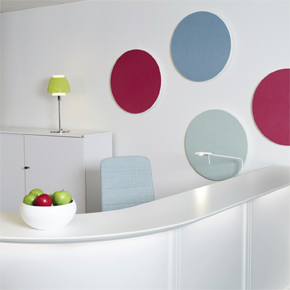
Simplified acoustics for retrofit
Poor acoustics can have a significant impact on the wellbeing of a building’s occupants. For commercial buildings and particularly offices, this can decrease employee productivity levels and job satisfaction, not to mention raising the number of sick days taken.
In this article, Will Jones of Ecophon talks to ABC+D about how simple improving acoustics can be for a retrofit project…
The open-plan design of modern office spaces can produce a wealth of acoustical challenges, such as combating intrusive noise from other people’s conversations, telephones ringing or the steady hum of machines. Unwanted noise is estimated to cause workers to lose as much as 24 days of productivity a year.
There is a clear argument to be made for ensuring good acoustics in any building. Steps have certainly been made in the right direction, with specific acoustic recommendations and regulations having been introduced to protect employees’ hearing. However, the challenge is what can be done for retrofit projects where an old building has been repurposed as an office space. These buildings may have glass or wooden finishes and hard ceilings which act to amplify and reflect sound. What’s more, dealing with acoustical issues for retrofit projects may often be avoided due to the perception of added cost and/or disruption caused.
Vertical independent sound absorbers are a great solution; they help to reduce echoes and enhance speech, ultimately improving overall acoustic performance. Absorbers such as these are available in different sizes, shapes and colours for maximum flexibility, making creative potential virtually limitless. As such, they can be produced in either a smooth, easily cleaned surface – with colours inspired by nature – or a fabric textured finish that boasts a more colourful and on-trend palette.
For more challenging spaces, such as school sports halls, impact resistant panels and trims are also available. Standard shapes can be used in combination for creative designs and patterns to improve the room’s acoustics but working with, rather than against, the style and design of the room.
Most importantly, installation of an independent panel is easy and quick. In fact, it really can be as quick and easy as hanging a picture. This makes the specification of independent acoustic panels an effective solution from a design, acoustic performance and cost perspective, not to mention significantly reducing disruption within the workplace.
For an effective installation, a designer must first determine which activities will take place within the space and what the occupants’ sound preferences will be. This will help to ensure the best positioning of the panels. For example, what is the profile for concentrated versus collaborative tasks? Is the environment phone intensive?
What is the culture and personality of the team working within the space? Once that has been understood, the appropriate acoustic treatments can be used to increase speech clarity, reduce sound levels and propagation, to deliver a productive environment for the team occupying the space.
Even in smaller rooms, such as a meeting room, sound builds up, making it hard for a person speaking to be heard. This can cause issues for telephone or video conferencing meetings. Placing independent sound absorbers on two adjacent walls, close to the sound and centred at the height of the sound, will help to achieve optimum conditions; for example, at 1.2m from the floor, where people sit, and at 1.6m where most people stand. A small amount of absorption can make a space far more user-friendly.
The right acoustic design and products in place allow a building’s occupants to only hear what they need to. This doesn’t have to be limited to the design stage of a new build – a retrofit project can utilise the vertical independent sound absorbers that are now available to create a calmer and, ultimately, less stressful work environment in any building.
Latest news

15th April 2025
West Fraser: CaberDek earns top marks from Home Counties carpentry specialist
A specialist carpentry sub-contractor covering housing sites across a large swathe of the Home Counties has come to value CaberDek from the West Fraser range for a variety of reasons: not least because the high quality panel product doesn’t destroy his operatives’ electric saws!
Posted in Articles, Building Industry News, Building Products & Structures, Building Systems, Case Studies, Restoration & Refurbishment, Retrofit & Renovation, Roofs, Timber Buildings and Timber Products, Wooden products
15th April 2025
GEZE: The Role of Access Control Systems in Enhancing Building Safety
Jane Elvins, Specification and Business Development Manager at GEZE UK, delves into the role of access control systems in enhancing building safety…
Posted in Access Control & Door Entry Systems, Architectural Ironmongery, Articles, Building Industry News, Building Products & Structures, Building Services, Doors, Facility Management & Building Services, Health & Safety, Restoration & Refurbishment, Retrofit & Renovation, Security and Fire Protection
11th April 2025
Don’t Do a Dave! It’s Time to Lock FIT Show 2025 in Your Calendar!
It’s that time again – FIT Show is back! You could be forgiven for thinking there won’t be much new to see when FIT Show returns to the NEC from 29 April – 1 May. Wrong!
Posted in Articles, Building Industry Events, Building Industry News, Building Products & Structures, Building Services, Continuing Professional Development (CPD's), Exhibitions and Conferences, Information Technology, Innovations & New Products, Restoration & Refurbishment, Retrofit & Renovation, Seminars, Training
11th April 2025
Insight Data: Boost construction success with project and prospect data
For those working in construction – in whatever capacity – the last few years haven’t been much fun. And according to the latest statistics, it would seem the challenges are continuing – Alex Tremlett, Insight Data’s Commercial Director, has more…
Posted in Articles, Building Industry News, Building Services, Information Technology, news, Research & Materials Testing
 Sign up:
Sign up: 